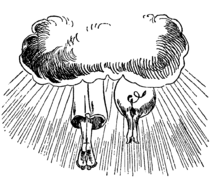Saint Anthony of Padua
Saint Anthony of Padua is one of the early closed picture stories by the humorous draftsman and poet Wilhelm Busch from 1864, published in 1870. Similar to Die pious Helene (1872) and Father Filucius (1872), the picture story is shaped by Wilhelm Busch's anti-clerical stance .
content
The Protestant -educated Wilhelm Busch doubted the concept of holiness, pessimistic in Busch's humanity was not possible. “Having grown up in Protestant views, it must have seemed strange to me that there should seriously be a real saint, a person without sin.” Accordingly, Wilhelm Busch turned this satire against the image of the Catholic Church .
The victim of his pictorial satire cannot be clearly identified. The name refers to Anthony of Padua , the Portuguese-Italian Franciscan , theologian and preacher who died in 1231 . Motifs in the picture story seem to be taken from the life of Antony the Great . Wilhelm Busch shows him as a mischievously calculating person who curbs his human sinfulness in order to secure the more constant joys at the side of the queen of heaven Mary . He is not averse to erotic adventures; temptation appears to him as a ballet artist. As an ascetic Klausner, he asks for a credible sign, whereupon a pig appears:
“And lo and behold! - From the middle of the forest,
a wild boar comes walking along. "
From this moment the ascetic and the pig live together until they die together and both are accepted into paradise together. Mary as Queen of Heaven receives the two with the words:
"Welcome! Enter in peace!
No friend is divorced from friend here. Quite a
few sheep come in,
why not a good pig too !! "
effect
Saint Anthony of Padua appeared when Pius IX. in the 1st Vatican Council proclaimed the dogma of papal infallibility , which the Protestant world rubbed against. The picture story was published by the Moritz Schauenburg publishing house, which published, among other things, Kommers books with songs by the fraternities who campaigned for a united and free Germany. The publisher's publications were therefore monitored particularly closely by the censors . Saint Anthony of Padua was confiscated. On July 8, 1870, the public prosecutor in Offenburg charged the publisher Moritz Schauenburg with "degrading religion and causing public nuisance through indecent writings", an accusation that hit Wilhelm Busch very much. But on March 27, 1871, the court in Offenburg acquitted the publisher. In Austria, however, the work remained banned until 1902.
Moritz Schauenburg rejected the publication of Wilhelm Busch's next, partly anti-clerical picture story. The Pious Helene was therefore published by Bassermann Verlag , which was headed by Wilhelm Busch's long-time friend Otto Friedrich Bassermann . Unlike Saint Anthony , there was no charge here.
expenditure
- Wilhelm Busch: St. Anthony of Padua. Frankfurt am Main 1871. In: Rolf Hochhuth (ed.): Wilhelm Busch, Complete Works and a selection of the sketches and paintings in two volumes. Volume 2 Whatever is popular is also allowed. Bertelsmann, Gütersloh 1959, pp. 32–90 (see pp. 91–97: The temptation of St. Antonius. A ballet ).
literature
- Wolfgang Becker: Wilhelm Busch as an evangelistic publisher (= contributions to evangelism and community development . Volume 14). Neukirchner, Neukirchen-Vluyn 2010, ISBN 978-3-7887-2444-3 (Slightly edited dissertation University of Greifswald [2010], 563 pages with CD-ROM)
- Michaela Diers: Wilhelm Busch, life and work. dtv, Munich 2008, ISBN 978-3-423-34452-4 .
- Joseph Kraus: Wilhelm Busch. Rowohlt, Reinbek near Hamburg 1970, ISBN 3-499-50163-5 .
- Gudrun Schury: I wish I were an Eskimo. The life of Wilhelm Busch. Biography . Structure, Berlin 2007, ISBN 978-3-351-02653-0 .
- Gert Ueding : Wilhelm Busch. The 19th century in miniature. Insel, Frankfurt am Main. 1977 (new edition 2007).
- Eva Weissweiler : Wilhelm Busch. The laughing pessimist. A biography . Kiepenheuer & 7Witsch, Cologne 2007, ISBN 978-3-462-03930-6 .
- Berndt W. Wessling : Wilhelm Busch - philosopher with a pointed pen. Heyne, Munich 1993, ISBN 3-453-06344-9 .
Web links
Individual evidence
- ↑ Saint Anthony of Padua in Wikisource
- ↑ Quoted from Kraus, p. 62
- ↑ Wessling, p. 92 f.
- ↑ Weissweiler, p. 168
- ↑ Weissweiler, p. 166 f.
- ↑ Weissweiler, pp. 169–172.




